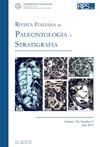EOCENE STALKED CRINOIDS IN THE GENUS ISSELICRINUS (ECHINODERMATA, CRINOIDEA, ISOCRINIDA) FROM NORTHEASTERN ITALY
IF 1.6
3区 地球科学
Q2 GEOLOGY
引用次数: 0
Abstract
Long fragments of isocrinid stalks belonging to the stalked crinoid genus Isselicrinus (Isocrinida, Isselicrininae) were found at Cambrigar, near Ferrara di Monte Baldo (Verona province, northeastern Italy) in the strata called “Harpactocarcinus punctulatus and Pentacrinus diaboli horizon”, traditionally ascribed to the lower Eocene (Ypresian). Morphometric analysis of this material allowed us to identify two distinct species filtering their food at different levels of the water column. The first species, characterized by a mostly pentagonal stalk section, is ascribable to Isselicrinus diaboli (Bayan), a taxon frequently cited from the lower Eocene of northeastern Italy but until now poorly known. The other species has a marked star-shaped stalk section presenting a combination of pedomorphic characters and is ascribed to the new taxon Isselicrinus baldoensis n. sp. A detailed analysis of numerous columnals and pluricolumnals of Isselicrinus diaboli from the type-locality of San Pancrazio near Mossano (Berici Hills, Vicenza province, northeastern Italy) allowed us to propose a revised and more complete diagnosis of this taxon. The particular burial conditions and the ecology of these two species are discussed as well as a reappraisal of the age of the “Harpactocarcinus punctulatus and Pentacrinus diaboli horizon”. Based on new calcareous nannofossil data, and confirmed by the larger foraminiferal assemblages, the isocrinids from Cambrigar are firmly assigned to the Lutetian (middle Eocene). Calcareous nannofossils identified in the matrix of historical hand specimens from the classical locality of San Pancrazio indicate a similar age.来自意大利东北部的始新世有柄棘皮动物伊斯利克林属(棘皮动物门,棘皮动物纲,伊斯利克林目
在意大利东北部维罗纳省费拉拉迪蒙特巴尔多附近的坎布里加尔(Cambrigar)的 "Harpactocarcinus punctulatus and Pentacrinus diaboli horizon "地层中,发现了属于有柄棘皮动物属 Isselicrinus(Isocrinida,Isselicrininae)的长形异棘皮动物茎秆碎片,该地层传统上被归入下始新世(Ypresian)。通过对这些材料进行形态分析,我们确定了在水柱不同层面过滤食物的两个不同物种。第一个物种的茎部主要呈五角形,可归属于 Isselicrinus diaboli(Bayan),这是意大利东北部下始新世的一个常被引用的类群,但迄今所知甚少。对来自莫萨诺附近圣潘克拉齐奥(意大利东北部维琴察省贝里奇山)模式产地的 Isselicrinus diaboli 的大量柱状体和多柱状体进行详细分析后,我们对这一分类群提出了经过修订的更完整的诊断。我们讨论了这两个物种的特殊埋藏条件和生态学,并重新评估了 "Harpactocarcinus punctulatus 和 Pentacrinus diaboli 地层 "的年代。根据新的钙质化石数据,并经大型有孔虫集合体的证实,坎布里加尔的有孔虫被确定归属于鲁特纪(中始新世)。在圣潘克拉齐奥(San Pancrazio)经典地点的历史手工标本基质中发现的钙质化石也表明了类似的年代。
本文章由计算机程序翻译,如有差异,请以英文原文为准。
求助全文
约1分钟内获得全文
求助全文
来源期刊
CiteScore
3.60
自引率
4.30%
发文量
28
审稿时长
>12 weeks
期刊介绍:
The Rivista Italiana di Paleontologia e Stratigrafia was founded in 1895. It publishes original papers dealing with all fields of paleontology and of stratigraphy, from Italy and the Mediterranean to the Tethys, as well across the globe from China to North America.

 求助内容:
求助内容: 应助结果提醒方式:
应助结果提醒方式:


